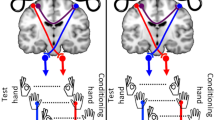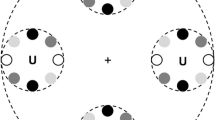Abstract
When a visual target is presented to one hemifield, manual responses made to the target using the ipsilateral hand (uncrossed responses) are faster than responses using the contralateral hand (crossed response), because there is no need for visuomotor information to be transferred between the hemispheres. This difference in response times is termed the crossed–uncrossed difference (CUD) and is a valuable means of estimating interhemispheric transfer time. We aimed to investigate the CUD by applying repetitive transcranial magnetic stimulation (rTMS) over the left and right occipital cortex during a lateralized target-detection task. Eleven neurologically healthy subjects, all right-handed, participated in the study. Relative to sham TMS we increased the CUD, by inhibiting the crossed latencies, but only when rTMS was applied to the hemisphere receiving visual information. These results replicate and extend previous findings and suggest the inhibitory rTMS effect under the crossed condition might be because the weak visual output is unable to activate the crossed pathway.


Similar content being viewed by others
Reference
Amassian VE, Cracco RQ, Maccabee PJ, Cracco JB, Rudell A, Eberle L (1989) Suppression of visual perception by magnetic coil stimulation of human occipital cortex. Electroencephalogr Clin Neurophysiol 74:458–462
Auclair L, Sieroff E (2002) Attentional cueing effect in the identification of words and pseudowords of different length. Q J Exp Psychol A 55:445–463
Chiang TC, Walsh V, Lavidor M (2004) The cortical representation of foveal stimuli: evidence from quadrantanopia and TMS-induced suppression. Cognitive Brain Res 21:309–316
Hershenson M (1962) Reaction time as a measure of intersensory facilitation. J Exp Psychol 63:289–293
Iacoboni M, Zaidel E (2004) Interhemispheric visuo-motor integration in humans: the role of the superior parietal cortex. Neuropsychologia 42:419–425
Ilmoniemi RJ, Virtanen J, Ruohonen J, Karhu J, Aronen HJ, Näätänen R, Katila T (1997) Neuronal responses to magnetic stimulation reveal cortical reactivity and connectivity. NeuroReport 8:3537–3540
Kammer T (1999) Phosphenes and transient scotomas induced by magnetic stimulation of the occipital lobe: their topographic relationship. Neuropsychologia 37:191–198
Lavidor M, Ellis AW (2003) Interhemispheric integration of letter stimuli presented foveally or extra-foveally. Cortex 39:69–83
Lavidor M, Walsh V (2003) A magnetic stimulation examination of orthographic neighbourhood effects in visual word recognition. J Cogn Neurosci 15:354–363
Marg E (1991) Magnetostimulation of vision: direct noninvasive stimulation of the retina and the visual brain. Optom Vis Sci 68:427–440
Marzi CA, Bisiacchi P, Nicoletti R (1991) Is interhemispheric transfer of visuomotor information asymmetric? Evidence from a meta-analysis. Neuropsychologia 29:1163–1177
Marzi CA, Miniussi C, Maravita A, Bertolasi L, Zanette G, Rothwell JC, Sanes JN (1998) Transcranial magnetic stimulation selectively impairs interhemispheric transfer of visuo-motor information in humans. Exp Brain Res 118:435–438
Marzi CA, Perani D, Tassinari G, Colleluori A, Maravita A, Miniussi C, Paulesu E, Scifo P, Fazio F (1999) Pathways of interhemispheric transfer in normals and in a split-brain subject. A positron emission tomography study. Exp Brain Res 126:451–458
Munchau A, Bloem BR, Irlbacher K, Trimble MR, Rothwell JC (2002) Functional connectivity of human premotor and motor cortex explored with repetitive transcranial magnetic stimulation. J Neurosci 22:554–561
Nickerson RS (1973) Intersensory facilitation of reaction time: energy summation or preparation enhancement? Psychol Rev 80:489–509
Oldfield RC (1971) The assessment and analysis of handedness: the Edinburgh inventory. Neuropsychologia 9:97–113
Tettamanti M, Paulesu E, Scifo P, Maravita A, Fazio F, Perani D, Marzi CA (2002) Interhemispheric transmission of visuomotor information in humans: fMRI evidence. J Neurophysiol 88:1051–1058
Trompetto C, Bove M, Marinelli L, Avanzino L, Buccolieri A, Abbruzzese G (2004) Suppression of the transcallosal motor output: a transcranial magnetic stimulation study in healthy subjects. Exp Brain Res 158:133–140
Walsh V, Pascual-Leone A (2003) Transcranial magnetic stimulation: a neurochronometrics of mind. MIT Press
Wise SP, Boussaoud D, Johnson PB, Caminiti R (1997) Premotor and parietal cortex: corticocortical connectivity and combinatorial computations. Annu Rev Neurosci 20:25–42
Acknowledgments
This study was supported by the Royal Society, The Wellcome Trust (ICN), the European Commission, and a BBSRC research grant (M. Lavidor). We wish to thank Vincent Walsh for his helpful comments.
Author information
Authors and Affiliations
Corresponding author
Rights and permissions
About this article
Cite this article
Chiang, TC., Lavidor, M. Magnetic stimulation and the crossed–uncrossed difference (CUD) paradigm: selective effects in the ipsilateral and contralateral hemispheres. Exp Brain Res 160, 404–408 (2005). https://doi.org/10.1007/s00221-004-2166-9
Received:
Accepted:
Published:
Issue Date:
DOI: https://doi.org/10.1007/s00221-004-2166-9




